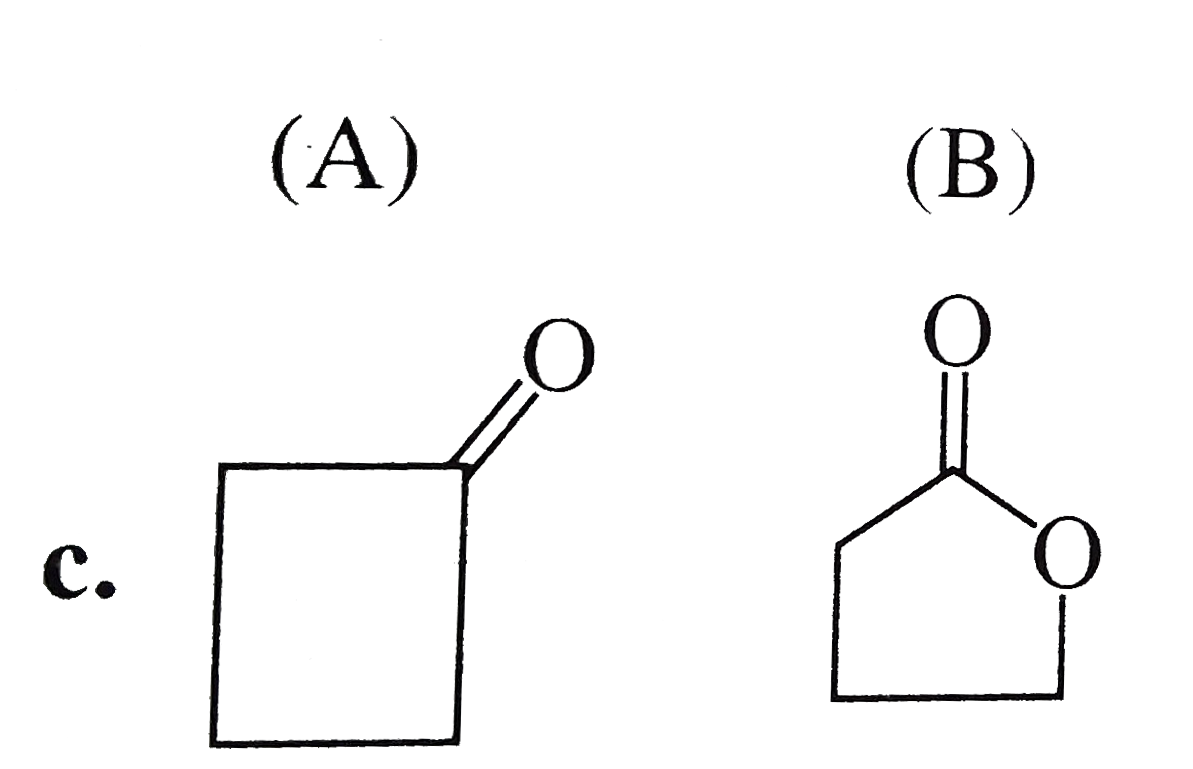BariumadipateDrydistillation−−−−−−−−→(A)MeCO3H−−−−−→(B)
The compounds (A) and (B), respectively, are:
a.
b.
c.
d.
The correct Answer is:B
To solve the question, we will follow these steps:
Step 1: Identify the structure of Barium Adipate
Barium adipate is a barium salt of adipic acid, which has the formula Ba(C6H10O4). It consists of a six-carbon chain with two carboxylic acid groups at each end.
Step 2: Dry Distillation of Barium Adipate
When barium adipate undergoes dry distillation, it decomposes to form barium carbonate and cyclopentanone. The reaction can be summarized as follows:
Barium adipateDry Distillation−−−−−−−−−→Cyclopentanone+BaCO3
Step 3: Determine Compound A
From the dry distillation of barium adipate, we obtain cyclopentanone. Thus, compound A is:
Compound A=Cyclopentanone
Step 4: Reaction with Peroxy Acid
Next, we add peroxy acid (specifically, MeCO3H) to compound A (cyclopentanone). This reaction is known as Baeyer-Villiger oxidation, which converts ketones into esters or lactones.
Step 5: Determine Compound B
The reaction of cyclopentanone with peroxy acid results in the formation of a six-membered lactone. The structure of compound B can be represented as follows:
Compound B=Cyclohexanone (or a related lactone structure)
Conclusion
Thus, the compounds (A) and (B) are:
- Compound A: Cyclopentanone
- Compound B: A six-membered lactone derived from cyclopentanone.
Final Answer
- Compound A: Cyclopentanone
- Compound B: A six-membered lactone
Barium adipate is a barium salt of adipic acid, which has the formula Ba(C6H10O4). It consists of a six-carbon chain with two carboxylic acid groups at each end.
When barium adipate undergoes dry distillation, it decomposes to form barium carbonate and cyclopentanone. The reaction can be summarized as follows:
Barium adipateDry Distillation−−−−−−−−−→Cyclopentanone+BaCO3
From the dry distillation of barium adipate, we obtain cyclopentanone. Thus, compound A is:
Compound A=Cyclopentanone
Next, we add peroxy acid (specifically, MeCO3H) to compound A (cyclopentanone). This reaction is known as Baeyer-Villiger oxidation, which converts ketones into esters or lactones.
The reaction of cyclopentanone with peroxy acid results in the formation of a six-membered lactone. The structure of compound B can be represented as follows:
Compound B=Cyclohexanone (or a related lactone structure)
Thus, the compounds (A) and (B) are:
- Compound A: Cyclopentanone
- Compound B: A six-membered lactone derived from cyclopentanone.
- Compound A: Cyclopentanone
- Compound B: A six-membered lactone
Topper's Solved these Questions
- REDUCTION AND OXIDATION REACTION OF ORGANIC COMPOUNDSBOOK - CENGAGE CHEMISTRY ENGLISHCHAPTER - REDUCTION AND OXIDATION REACTION OF ORGANIC COMPOUNDSEXERCISE - Exercise (Assertion And Reasoning)
10 Videos
- REDUCTION AND OXIDATION REACTION OF ORGANIC COMPOUNDSBOOK - CENGAGE CHEMISTRY ENGLISHCHAPTER - REDUCTION AND OXIDATION REACTION OF ORGANIC COMPOUNDSEXERCISE - Exercise Archives (Subjective)
26 Videos
- REDUCTION AND OXIDATION REACTION OF ORGANIC COMPOUNDSBOOK - CENGAGE CHEMISTRY ENGLISHCHAPTER - REDUCTION AND OXIDATION REACTION OF ORGANIC COMPOUNDSEXERCISE - Exercise (Multiple Correct)
35 Videos
- QUALITATIVE INORGANIC SALT ANALYSISBOOK - CENGAGE CHEMISTRY ENGLISHCHAPTER - QUALITATIVE INORGANIC SALT ANALYSISEXERCISE - Viva Voce Questions And Part-C (Analysis Of Cations)
42 Videos
- SOLID STATEBOOK - CENGAGE CHEMISTRY ENGLISHCHAPTER - SOLID STATEEXERCISE - Ex 1.2 (Objective)
9 Videos
Similar Questions
 (i)CH3CHO−−−−−−−→(ii)H3O+ (A) HBr−−→ (B)
(i)CH3CHO−−−−−−−→(ii)H3O+ (A) HBr−−→ (B)
The compounds (A) and (B)
View SolutionCH3−C≡NH2O/Δ−−−−→(A)H2O/H+−−−−−→(B)(A)and(B) respectively are
View SolutionKetone (A) NH2OH.HCl−−−−−−−−→ (B) H⊕−−→

The ketone (A) and compound (B), respectively, are:
Ketone (A)
I.
Compound (B)
View SolutionSOCl2−−−→(A)KCN−−→(B)H+−−→(C ), the compound (C ) is

View SolutionAcetone HCN−−→(A)H3O+−−−→(B). In the above sequence of reaction A and B are :
View SolutionConsider the following reaction ,
C6H5NH2+CHCl3+KOHΔ−−→(A)H+/H2O−−−−−→(B)+(C)
The compounds (B) and (C) are :-
View SolutionAldehyde (A) NH2OH.HCl−−−−−−−−→ (B) H⊕−−→MeNH2+HCOOH
Aldehyde (A) and compound (B), respectively are:
Aldehyde (A)
I. MeCHO II. HCHO
Compound (B)
III.
View SolutionLet →C=→A+→B then :
View SolutionWhat is meant by DNA a−−→ RNA b−−→ Protein?
View SolutionH3BO3(s)+aq.NaOHΔ−−→(X),
H3BO3(s)+moltenNaOHΔ−−→(Y)
Compound (X) & (Y) are respectively,
View Solution
